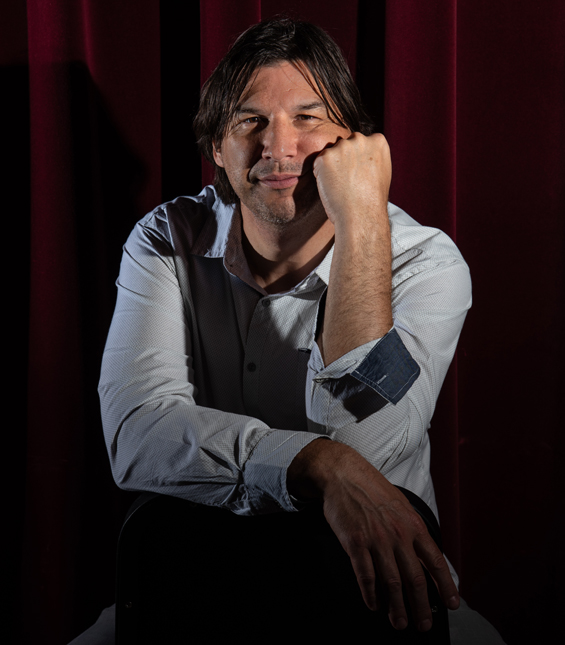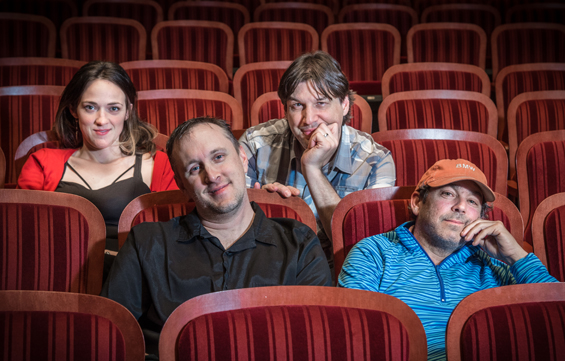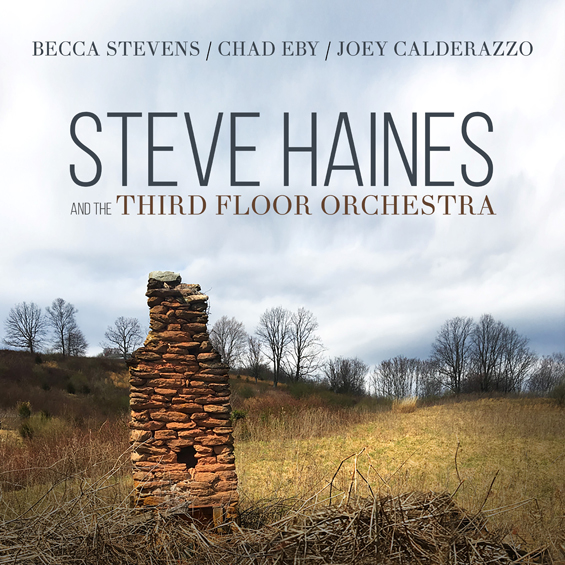

FIVE QUESTIONS WITH STEVE HAINES
A standout release in this still young year is the self-titled one bassist, arranger-composer, and educator Steve Haines has just issued with the Third Floor Orchestra. The latter's contributions are integral to the project, but so too are those by singer Becca Stevens, soprano saxophonist Chad Eby, and pianist Joey Calderazzo. Eleven pieces appear on the release, including a folk traditional, Chopin mazurka, original songs by both Haines and Stevens, and, perhaps most audaciously, orchestral re-imaginings of four Canadian classics: Neil Young's “Harvest Moon,” Leonard Cohen's “Hallelujah,” Gordon Lightfoot's “If You Could Read My Mind,” and Kim Mitchell and Pye Dubois' “Patio Lanterns.” The seed for the project was planted years ago when Haines wrote a string quartet arrangement for Stevens, which in turn made the bassist want to learn more about writing for orchestra. The eventual product of that desire, Steve Haines and the Third Floor Orchestra (reviewed here), is an album to treasure, one of those rare recordings where every song has something to recommend it. A few weeks ago, textura was fortunate to speak with the bassist about the recording and learn more about how it came into being.
1. You grew up in Ottawa, obtained your undergraduate degree in Jazz Performance at St. Francis Xavier University in Nova Scotia, and earned your Master's in Music (Jazz Studies) at the University of North Texas. For nearly two decades, you've been the director of the Miles Davis Jazz Studies Program at the University of North Carolina in Greensboro, where you live with your family, and you've released four albums. What other details will give us a fuller picture of who Steve Haines is?
That covers a lot of it. I have two-year old twins, Violet and Jimmy, and Ben just turned four. My family and my music keep me really busy, but I still find time to play hockey once a week.
2. Beginner's Mind (2003), Stickadiboom (2009), and Secret Stash (2017), the three albums that preceded Steve Haines and the Third Floor Orchestra, are quartet or quintet recordings. What prompted the dramatic shift from small group jazz recordings to the large-scale orchestral scope of the new release? And is there a particular goal you had in mind for the project that you set out to achieve?
There were a few reasons for this recording. The biggest one is that I wanted to learn more about writing for orchestra. I thought to myself, “What if it's not a rhythm section that accompanies the melody but an orchestra instead?” Also I wanted to make an album that musicians (like me) and non-musicians (like my wife) would enjoy. Sometimes jazz musicians are so concerned with innovation that when they look up, no one's listening. At least for now, it was fun to try to thread the needle there.

Becca Stevens, Chad Eby, Steve Haines, Joey Calderazzo (photo: Brad McMillan)
3. The impression that forms as one listens to the recording is that you share a history with singer Becca Stevens, soprano saxophonist Chad Eby, and pianist Joey Calderazzo that long preceded this project. If that's so, when did your relationships with them form, and had you always hoped to one day feature them on a project like this one? And could you say a few words about what each one brought to the recording?
Thank you for that, and I'm glad you noticed. My favourite things to listen to are not really individuals but bands that have a history, like the John Coltrane Quartet, the Miles Davis Quintets, the Oscar Peterson Trio. I think the reason they're successful is because of the time they put in as a band. As for Becca, Chad, and Joey, the whole writing process was built around who they are, so they had to buy in on the idea from the very beginning. The idea of the orchestra was to wrap them up in warm blanket. I've known and worked with all of them for a long time. We have a history, and they're the best. I find each of them inspiring for different reasons.
4. As a lifelong Ontario resident, I couldn't help but be struck by a setlist that includes no less than four Canadian music staples: Neil Young's “Harvest Moon,” Gordon Lightfoot's “If You Could Read My Mind,” Leonard Cohen's “Hallelujah,” and Kim Mitchell's “Patio Lanterns.” What it is about these particular songs that resonated so strongly with you that you chose them for the recording project?
For people like me who are born in Canada and live abroad, I think it's fair to say that having our identities rooted in part as a Canadian is essential. I still keep my ear to the ground with respect to Canadian musicians and politics, that kind of thing. And yet the decision for these tunes was not really a conscious one. I wanted to find songs that've had an impact on me. “Patio Lanterns,” for example, that one was a huge hit in the Canadian ‘80s and has such a sweetness and endearment to it. Becca wanted to do “Hallelujah.”

5. A few other cross-genre releases come to mind by bassists that feature a singer and full orchestra, among them Sifting Stars, a wonderful 2018 recording by Matt Ulery, and The Art of the Song, Charlie Haden's 1999 Quartet West recording with Shirley Horn and Bill Henderson. Did you have any particular models in mind as you were preparing your own project or was it one that simply developed naturally out of what you've done before?
I have to check out Matt Ulery! Thanks for hipping me to him. Mostly, the project grew out of a string quartet arrangement I'd done for Becca on her tune “Fine Lines.” Also, in general I've been listening to music outside of jazz quite a bit, since jazz is sort of my wheelhouse, so I got more curious with strings, that kind of thing. I did hear Sting play with an orchestra in Durham a few years ago, which I thought was pretty neat. What I love most about the really good jazz musicians is that they go after their weakness head on. For me, I'm not afraid of failing, I'm afraid of not trying.
Bonus question: On the inner sleeve, you state that you “wanted to start learning how to write for orchestra” and “spent lots of time listening.” What challenges did writing for a full orchestra present and specifically what did you listen to by way of preparation?
In terms of challenges, when adding a rhythm section to a full orchestra, the biggest challenge is the ride cymbal. The ride can all by itself wipe out an entire string section so it needs to be handled with care. The other issue I had involved the string section. I needed to double the string players by having them play another take over themselves; Vince Mendoza helped me with this process.
To prepare, I listened to lots of composers—Chopin, Beethoven, Brahms, etc.—and all for different reasons. I listened for voice leading, textures, how many lines there were at one time, who doubled whom, how often people play, stuff like that. One day I said to a wonderful clarinetist, “When the strings are in unison, I can't hear the clarinets,” to which he said “Check out Dvorák's Cello Concerto.” For something I couldn't understand, I'd write it down, like, for example, Aaron Copland's A Quiet City. That sounds like a bigger deal than it was as there's nothing really there. What I learned from that piece is that you can move a mountain with one person playing one note. It's one of the greatest pieces of music, yet it's very simple. My latest listening includes Arvo Pärt's ECM release The Symphonies, which is really incredible.
April 2019
![]()